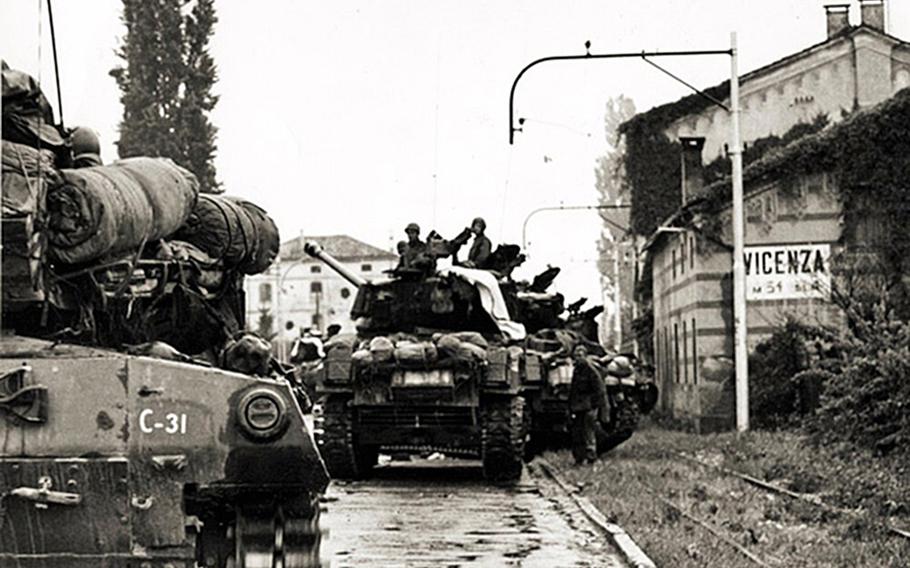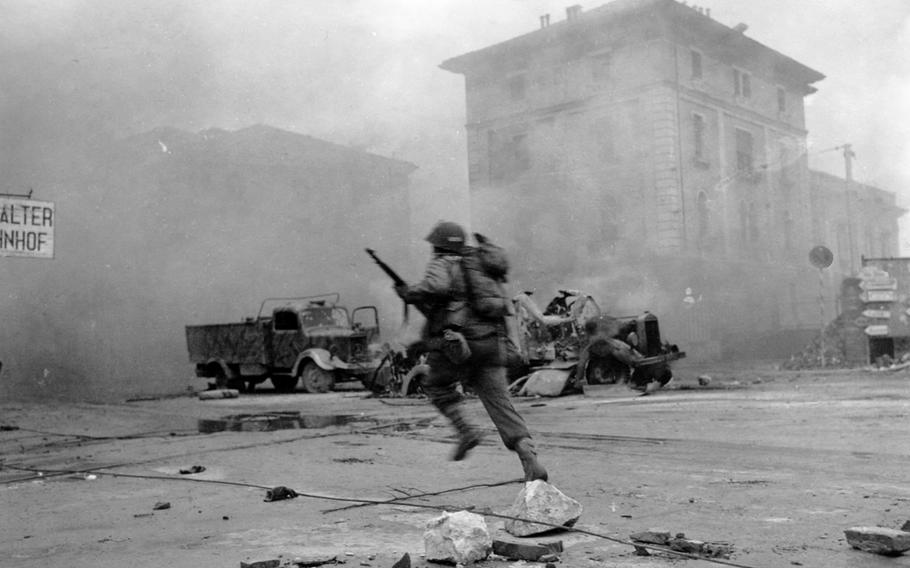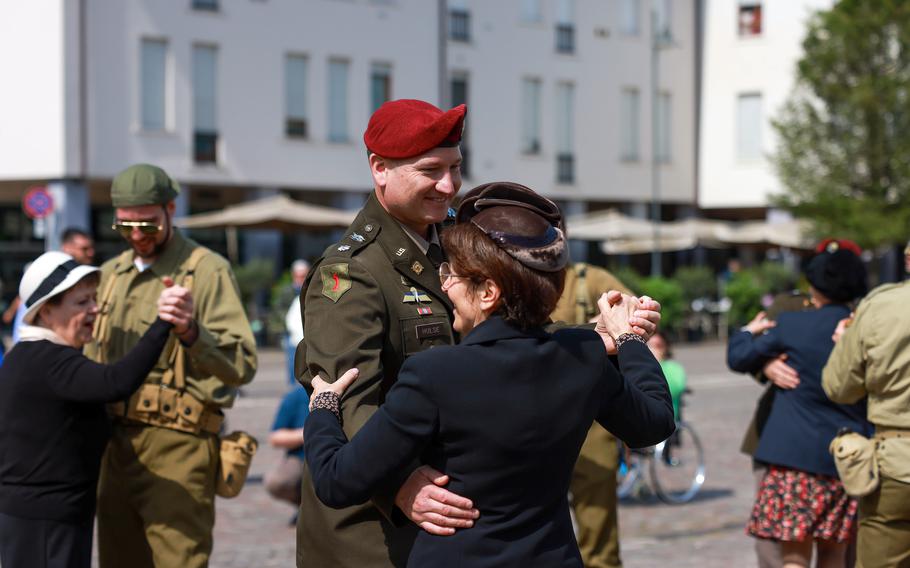
American tanks roll into Vicenza, Italy, after units captured the town from Axis forces April 28, 1945. The battle for Vicenza involved soldiers from the 752nd Tank Battalion and the 88th Infantry Division. (Robert Schmidt/U.S. Signal Corps)
VICENZA, Italy — Just over 80 years ago, American troops entered this Venetian city and defeated a ragged but determined German force to reclaim it for an alliance on the cusp of victory in Europe.
On Monday, a slate of reminders sought to drive the story of Vicenza’s liberation home for those serving today.
“You can’t go very far in Vicenza without tripping over our historical past,” said Kevin Shea, a U.S. Army Reserve officer and field historian working at Caserma Ederle as a contractor.
A small group of soldiers toured World War II battle sites around Vicenza on Monday, with Shea providing narration.
Vicenza was a major transport and communications hub for the Germans thanks to its new roads, rail line and telegraph lines. It also had an air base at what is now Caserma Del Din.
In April 1945, the war was coming to a close. Allied forces were racing north to secure Italian borders and capture Germans, ideally in the Po Valley before they could reach the Alps and retreat.
American forces liberated Bologna before pushing toward Verona, where they had a brief but fierce engagement, then headed toward Vicenza, according to Shea.
That set the stage for the Battle of Vicenza on April 27-28.
Bob Holt, historian of the 752nd Tank Battalion based in Connecticut, has dedicated decades to studying this portion of the war, partly because his father fought in it.
The disorganized German forces were falling apart and had resorted to horse-drawn carriages, he said. But there were still thousands of them streaming toward Vicenza, often in ad hoc units.
“In many cases, they were totally unaware that U.S. troops were already in the towns they were streaming toward,” Holt said.
After a vicious engagement outside Vicenza on April 27, the 88th Division Task Force Frye prepared to enter the city.
On the following morning, the Americans had about four tanks moving along the SR11 regional road when they were ambushed. From that point on, it was a tough fight through the city.
“From a tanker perspective, urban combat is the worst possible scenario,” Holt said.
American troops were attacked by German snipers hiding in buildings, targeted with hand grenades thrown from roofs, and shot with panzerfaust, a weapon similar to a bazooka that fires projectiles that enter a tank and then destroy it from the inside out.
On top of that, they were forced to drive with their hatches open, heads fully exposed. Three Americans died in the battle, all from head wounds.

A soldier of the U.S. Army 88th Infantry Division runs to avoid German sniper fire on April 28, 1945, near Corso Santi Felice e Fortunato and Viale Milano in Vicenza, Italy. (Robert Schmidt/U.S. Signal Corps)
For the 752nd Tank Battalion, it was the worst casualty day of the entire war. Sixteen American soldiers were wounded in addition to the three killed, and five tanks were destroyed.
Eight Silver Stars and three Bronze Stars were awarded for actions in Vicenza that morning. The entire unit was awarded a distinguished unit citation.
“The spirit of these people needs to be remembered,” Holt said. “It wasn’t just a bunch of guys sending their men forward into battle. These were officers right up to the colonel of the infantry. These guys led from the front.”
After the battle, American forces continued their race toward the border, leaving Vicenza to rebuild. It was the most heavily bombed city in the Veneto region, with destruction to homes and iconic buildings.
The roof was burned off the Palladian Basilica in the center of town, and the main church was almost completely destroyed.
“Our front yards were a front line,” said Randall Jackson, chief of command information for U.S. Army Garrison Italy, who recently recorded a podcast about the battle. “New soldiers can’t relate without hearing these stories.”

U.S. Army Lt. Col. Ryan Hulse, commander of the 173rd Brigade Support Battalion (Airborne), and a Liberation Day actor dance during a parade in Montecchio Maggiore, Italy, April 27, 2025. U.S. soldiers assigned to the brigade participated in the celebration to commemorate 80 years since the liberation of Vicenza and surrounding communities. (Kylejian Francia/U.S. Army)
The 80th anniversary remembrances in and around Vicenza over the weekend also offered cause for jubilation.
In Montecchio Maggiore, just a few miles west of Vicenza, Army Sgt. William Cantrell of the 173rd Brigade Support Battalion was watching a group of Italians dancing in celebration Sunday and suddenly was pulled into the action himself, according to a U.S. Army Garrison Italy statement.
“I was on the side and this little old lady just took my hand,” said Cantrell, a Tennessee-born paratrooper. “I couldn’t say no.”
Italian reenactor Enrico Ricci was also on hand, wearing an American military uniform with a unit patch from the Army’s tank destroyer battalion.
“It’s important because it’s been a long time since the war,“ Ricci said, according to the garrison statement. “We can’t lose the stories.”
Also taking place Monday was a screening of “The Lost Mountaineers,” a documentary about the 25 men of the 10th Mountain Division who lost their lives in Lake Garda at the end of World War II.
A brief film that highlighted the Battle of Vicenza and included archival footage was played before the documentary.